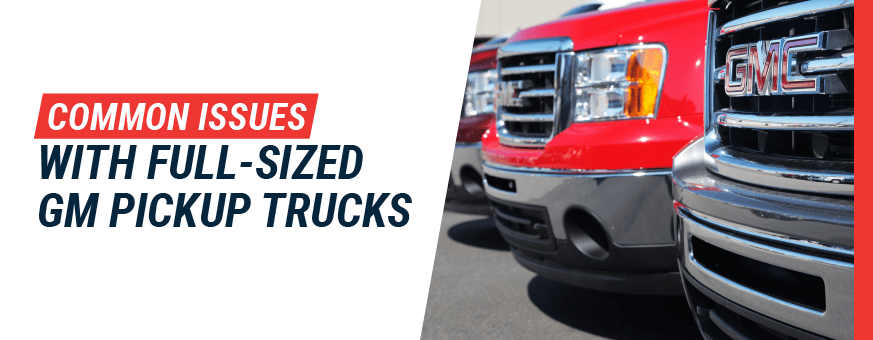
Full-sized GM pickup trucks are a staple of American culture. They have a rich history of hauling everything from construction materials to hay bales to camping gear, and they’re even a great choice for hauling your family around. General Motors has been one of the most popular truck manufacturers in the U.S. for decades.
Chevrolet introduced its first purpose-built truck, the One-Ton, in 1918, the same year the company merged with GM. Rapid Motor Vehicle Company, a precursor to GMC, produced some of the world’s first commercial trucks before joining GM in 1909 and merging with Reliance Motor Company to form GMC Truck. GM’s modern full-sized pickups, the Chevy Silverado and the GMC Sierra, are two of the most popular trucks on the road today.
While they’re reliable trucks overall, like all vehicles, GM pickups have their share of issues.
Quick Links:
- 2007-2013 Full-Sized GM Trucks
- 1999-2007 Full-Sized GM Trucks
- 1988-1998 Full-Sized GM Trucks
- 1939-1987 GM Truck Evolution
Common Issues With 2007-2013 Chevy Silverado and GMC Sierra Pickup Trucks
GM’s modern full-sized pickups are the Chevy Silverado and the GMC Sierra. Mechanically and, for the most part, stylistically, these trucks are identical, but they sell under two different brand names. The Silverado is more of the standard model, while the Sierra offers more high-end interior options and has a boxier trim.
Because these two trucks are the same mechanically, they typically share the same frequent problems. Let’s take a look at the issues you’re most likely to run into if you own one of these vehicles.
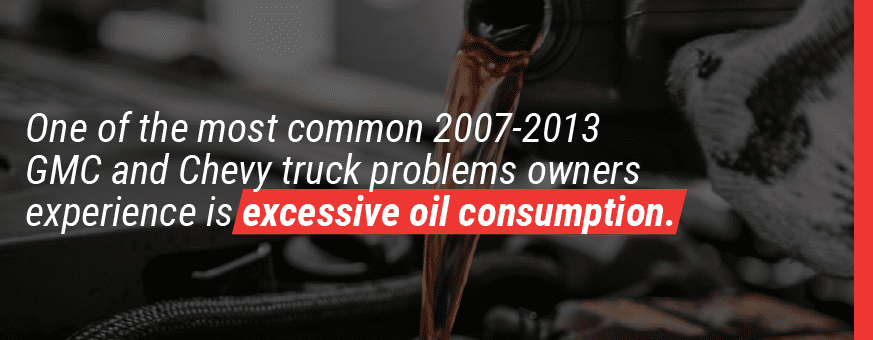
1. Excessive Oil Consumption
One of the most common 2007-2013 GMC and Chevy truck problems owners experience is excessive oil consumption.
This problem led vehicle buyers to launch a class-action lawsuit against GM, which alleged 2010-2013 vehicles with Generation IV 5.3 Liter V8 Vortec 5300 engines were defective. Specifically, the lawsuit claimed the active fuel management (AFM) system, piston rings and PVC system in these vehicles were faulty and caused excessive oil consumption, as well as premature spark plug degradation and engine malfunction.
The AFM system, which disables some of the engine’s cylinders at lower RPMs to reduce fuel use, is the most common cause of this issue. While the system accomplishes this, it also leads to oil use problems. Some drivers have reported using as much as a quart of oil every 1,000 miles. You’re most likely to start noticing excessive oil use around the 60,000-mile mark.
To help avoid problems, change your oil regularly. You might also consider carrying an extra quart of oil in your truck. Some drivers have used engine tuners to deactivate the AFM system — which can be an effective solution if you use a quality tuner that’s configured correctly to avoid damaging your vehicle.
2. Defective Speakers
Another frequently reported issue is that the speakers in recent Chevy Silverados and GMC Sierras go out. Most of the problems involved the speakers in the door. They typically quit working one at a time over several months, but occasionally kick back on and then stop working again after a short time. The problem may result from moisture that gets into the doors.
Most of the time, broken speakers mean a lack of convenient entertainment while driving, but they could potentially cause safety issues, as they could prevent you from using OnStar if all of them were to go.
The way to fix this issue is to replace the speakers. If you want a quick fix, you can buy a cheap set of speakers. If you go this route, you may run into the same problem at a later point. Investing in a set of more durable speakers may keep the problem at bay for longer.
3. Failure of 4WD Transfer Case Encoder Motor Position Sensor or Selector Switch
The 4WD case encoder motion position sensor and selector switch on these vehicles have been known to fail, typically at around 150,000 miles. If this sensor or switch fails, the vehicle will display the service 4WD message. This faulty 4WD issue is among the most common problems with the 2008 Chevy Silverado, according to reports from owners.
Often, the failure stems from the two ground wires attached to the frame under the driver’s door. Over time, dirt, moisture and corrosion can affect the contacts on the bolts used to attach the wires to the frame.
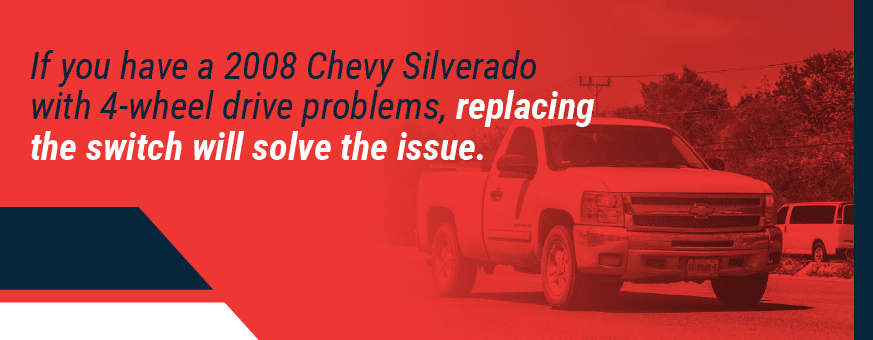
If you have a 2008 Chevy Silverado with 4-wheel drive problems, or a similar GMC or Chevy truck from another model year, replacing the switch will solve the issue. You can purchase a new switch for around $30 and install it fairly easily. To install it:
- Remove the bolts and clean the bolt threads and the ends of the wire attachments and clean down to the frame using a wire brush.
- Reattach the wires to the frame.
- Pull out the dash’s outer trim far enough that you can reach in and pull out the old switch.
- Unplug the two plugins from the switch and plug in the new ones
- Push the switch into the slot
- Push the trim back into place.
4. Frequent Battery Rundown
A considerable number of drivers have said the battery on their 2007-2013 Silverado or Sierra dies frequently. This could be caused by problems with the battery or other issues that cause the vehicle to run the battery down. Replacing your battery will cost around $200 and occurs on average at about 33,000 miles. You might also need to replace the alternator or body control module. Installing an extra battery in the extra tray in your truck can help you to avoid dead battery problems.
5. Failure of Heating and Air Conditioning Temperature or Delivery Mode Door Actuators
Many drivers have also reported their heat and air conditioning system is delivering the wrong temperature or amount of air. Often, this takes the form of the heater turning on unexpectedly or the system blowing hot air when it should be blowing cold. The cause of this issue is a failure of air delivery or temperature mode door actuators. Fault codes can help you make sure this is the cause of the problem. This issue usually begins to occur after around 125,000 miles.
If your HVAC system starts blowing hot air in the middle of the summer, restarting your vehicle will often work as a temporary fix. Replacing the actuators offers a permanent fix to the problem. Each actuator costs between $30 and $80.
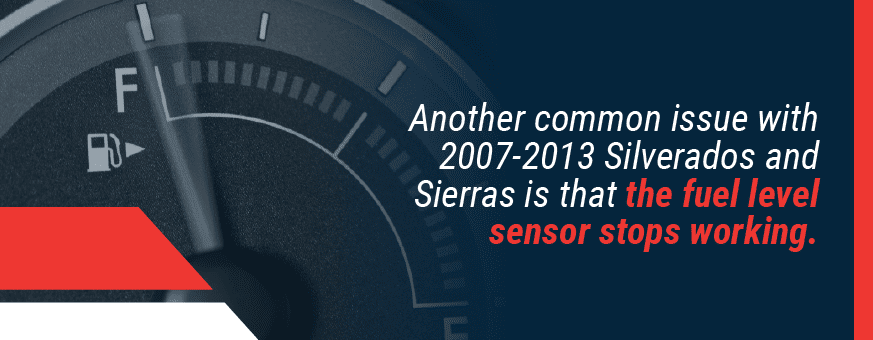
6. Incorrect Readings From Fuel Level Sensors
Another common issue with 2007-2013 Silverados and Sierras is that the fuel level sensor stops working. After approximately 120,000 miles, the fuel gauge may start misreading the fuel level or working inconsistently. You might find it always reads empty even right after you fill up the gas tank. It might also jump between full and empty. It may stop working entirely or alternate between working and not.
This problem has led some drivers to start keeping track of their mileage manually to avoid running out of gas. To fix this issue, you’ll need to replace the fuel level sensor. On vehicles with higher mileage, you may want to replace the entire fuel pump module, which typically costs around $1,000.
7. Erratic Speedometer and Other Instrument Panel Gauges
Some drivers have also reported problems with other instrumental panel gauges, especially the speedometer. The gauges may intermittently show the wrong reading or not work at all. The issue most often occurs after around 100,000 miles. To fix this problem, you may need to have the instrument panel replaced.
8. CD Player Failure
Another issue with the entertainment system in modern Silverados and Sierras is that the CD player is susceptible to failure because of a problem with the radio unit. Drivers have reported that their CD players have started making a whirring sound and then ejecting the disc whenever they try to put in a CD and eventually not accepting CDs at all. There have also been reports that the CD player continues to run as though it’s trying to eject a CD even if there isn’t a disc in the player. This may happen even after turning off the ignition, which could contribute to running the battery down.
This tends to happen after around 100,000 miles and usually requires you to send the radio unit in to a specialty repair shop.
9. Throttle Position Sensor Problems
If your check engine light comes on and you get a reduced power message, there may be a problem with your throttle position sensor. These sensors frequently have issues related to faulty wiring, a bad connection at the TPS or a failure of the TPS. If you suspect you have a problem with your TPS, you’ll need to get it inspected and potentially replace wiring or other parts. Replacing the entire TPS will likely cost between $100 and $250.
10. Continuous Running of Anti-Lock Brake System Pump
Drivers have also reported that the anti-lock brake system pump may continue running after turning off the ignition, causing the battery to die. This typically occurs at around 140,000 miles on average and may be caused by the transistor in the ABS unit burning out. To fix this problem, you’ll usually need to replace the ABS control module, which can cost between $683 and $839.
Shop 2007-2013 GM truck parts »
Common Problems With 1999-2007 Chevy Silverado and GMC Sierra Pickup Trucks
1999 marked the introduction of Silverado and Sierra models and the beginning of the modern era of GM full-sized pickup trucks. The most common Chevy truck problems include brake issues and a knock in the steering column. Let’s take a look at these common problems with 1999-2007 GM pickup trucks.
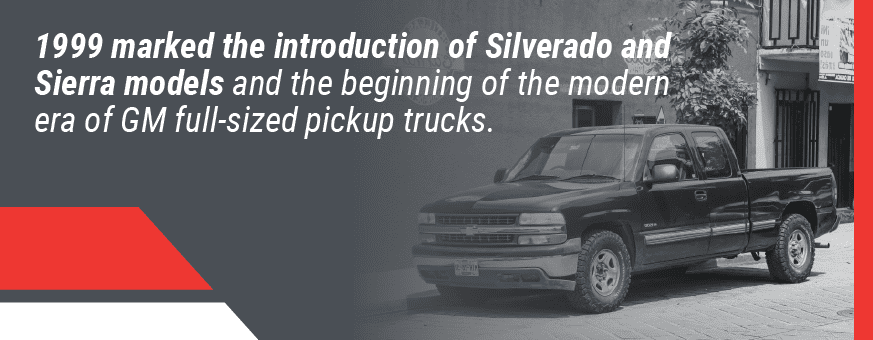
1. Parking Brake Failures
In 2005, Chevrolet and GMC issued a recall related to the parking brake system on specific pickup trucks with manual transmissions and either PBR or TRW parking brake systems. According to the recall, the friction linings on the parking brake may wear so severely that the parking brake cannot keep a parked vehicle immobile, which could result in a crash. You’ll likely notice this issue start to occur after around 60,000 miles, but it could emerge sooner.
To fix this flaw, Chevy and GMC dealers will install a low-force spring clip retainer for vehicles that have a PBR parking brake system. For those with a TRW parking brake system, dealers will put in a redesigned parking brake cable assembly. The recall number is 05V161000. Without the recall, this problem will typically cost around $250 to fix.
There are currently 15 active 2002 Chevrolet Silverado 1500 recalls, including this parking brake issue.
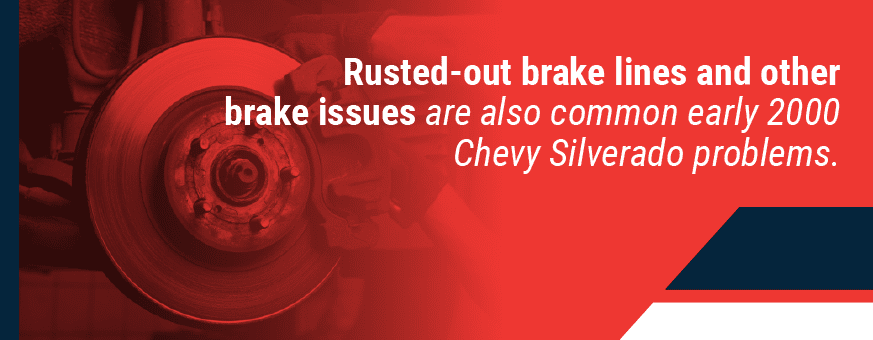
2. Rusted-Out Brake Lines
Another common issue with 1999-2007 Silverados and Sierras is rusted-out brake lines, causing the brakes to fail. This problem typically starts to occur after 100,000 miles. To fix this problem, you need to replace the rusted brake lines. When replacing a brake line, it’s advisable to check the others as well. If one rusted out, the others may have as well. The typical cost to fix this problem is around $1,200.
Some drivers have also reported other corrosion-related problems on fluid lines, additional brake components, driveshafts, underbodies and other areas. Rusted-out brake lines and other brake issues are also common early 2000 Chevy Silverado problems.
3. Steering Column Noise
Many Chevy Silverado and GMC Sierra drivers have reported hearing a knock or a clunking noise coming from the steering shaft. You’ll notice this sound when you turn the steering column. According to owners, this noise is one of the most commonly reported 1999 Chevrolet Silverado 1500 problems.
The source of the GMC Sierra and Chevy Silverado steering column noise is usually a bad intermediate steering shaft. On these vehicles, the steering shaft gets mounted to the truck body and the steering box attaches to the frame. When the truck body flexes on the frame, the shaft moves slightly. The steering shaft has a splined slip joint that has grease in the slip portion. Over time, the grease slowly moves to one end of the joint. The slight movement of the shaft then causes the noise. This problem typically starts to occur at around 60,000 miles, but could begin as early as 10,000 miles.
There are two main ways to fix the Sierra and Silverado steering shaft clunk. Periodically re-greasing the steering wheel should stop the noise, but isn’t a long-term solution. If you go this route, try re-greasing it every time you change the oil. You can also replace the stock two-piece steering shaft with a single aluminum shaft, which costs about $250.
4. Fuel Pump Failure
Fuel pump failure is one of the more frequently reported 2002 5.3 liter Chevy engine problems, although this issue is less common than some of the other problems in this list. You may also find this issue on other Silverado and Sierra models from 2000 and 2014. Some drivers have reported their fuel pumps have failed, causing the engine to stall and not restart. At first, you may temporarily lose power and then get it back. If the problem goes untreated, the vehicle will eventually stall out completely. Watch out for this problem after 100,000 miles.
Replacing the fuel pump, which costs between $700 and $800, will fix this problem. Replacing the fuel filter every 30,000 miles can help prevent it by reducing the amount of strain put on the pump.
5. Transmission Failure
Another less common issue is transmission failure. After around 70,000 miles, you may find the transmission feels jerky. You may also hear loud noises coming from the transmission. It may eventually die completely. There have also been reports of the transmission going out suddenly. Rebuilding the transmission is the solution to this problem and can cost around $2,000.
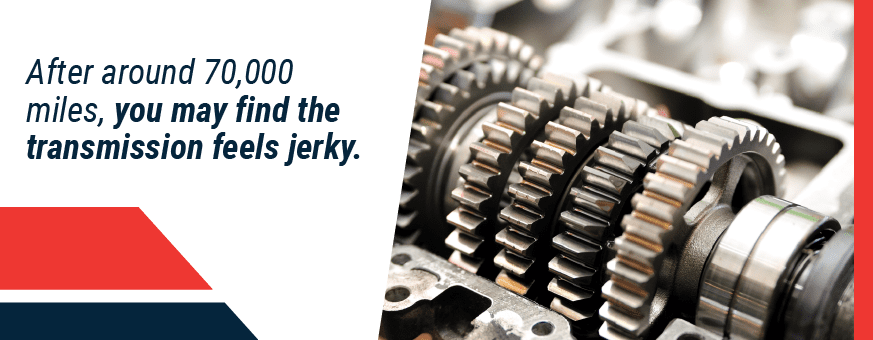
6. Flaking and Peeling Paint
The paint of Silverados and Sierras from this era may be more prone to flaking, peeling and chipping than the paint on many other vehicles. These issues can start to become relatively severe at around 90,000 miles. The only way to fix this issue is to have your truck repainted, which can cost approximately $3,500 to have it done professionally.
7. Electric Window Failure
Drivers of 1999-2007 Sierras and Silverados have reported problems with their electric windows. The windows in these vehicles may stop working due to faulty lifting mechanisms. At around 66,000 miles, you may find that your windows start to go out one by one. To fix these issues, you’ll need to replace the motors for the broken windows, which will cost approximately $1,000 to have done by a mechanic, slightly less if you choose to do the repair yourself.
Some drivers have said that they have had to replace motors multiple times.
8. Restricted Secondary Air Injection Valves
Silverados and Sierras made between 1999 and 2007 are prone to a problem in which the secondary air injection check valves become restricted, leading to reduced airflow and causing the check engine light to come on. Fixing this problem requires you to replace the check valves. Even if the fault code shows that the problem is only occurring with one bank of cylinders, you may want to replace both to avoid having the other one go out on you as well. This issue occurs on average at 133,000 miles, and may cost between $100 and $150 per valve.
9. Failed Steering Wheel Position Sensor
If you get a service stability message in your Silverado or Sierra, it may be because of a failed steering wheel position sensor. These errors may occur intermittently or more regularly, such as every time you start your truck or turn the wheel. Replacing the sensor, which will cost you about $200 to $300, should fix this issue. This issue could occur at any time, but the average mileage at which it occurs is around 90,000.
10. Problems Shared With 2007-2013 Models
1999-2007 Chevy Silverados and GMC Sierras are also known to experience some of the same common issues 2007-2013 models do. These include failed 4WD transfer case encoder motor position sensors or selector switches, failed HVAC temperature or delivery mode door actuators and failed fuel level sensors.
Shop 1999-2007 GM truck parts »
Common Issues With 1988-1998 GM Pickup Trucks
GM first introduced the Silverado and the Sierra in 1999, but the company produced these trucks’ predecessor, the C/K pickup, for many years before that. C meant two-wheel drive, while K indicated four-wheel drive. GM used the names Silverado and Sierra during this time, but instead of describing a model, they described trim packages for the C/K trucks. The fourth generation of C/K trucks, which became available in 1988, featured a more modern design and were the first to use the GMT400 platform. In this section, we’ll look at some common issues with GM pickup trucks produced from 1988 to 1998.
1. Windshield Wiper Motor Component Failure
The windshield wipers on models made between 1990 and 1999 may stop working intermittently due to a defective wiper motor control board. Auto manufacturers issued recalls for this problem on some models. If you experience trouble with your windshield wipers, check with a dealer to see if there is a recall on your vehicle.
If you have a faulty wiper motor control board, your wipers may, at times, stop working, fail to turn on or keep running after you turn them off. You might also find your wipers only work on one speed setting.
When the wipers are not working, you should hear the motor control box buzzing. As a temporary fix to the problem, lightly tap on the control box, and the blades should start working again. For a more permanent fix, replace the wiper motor control board.
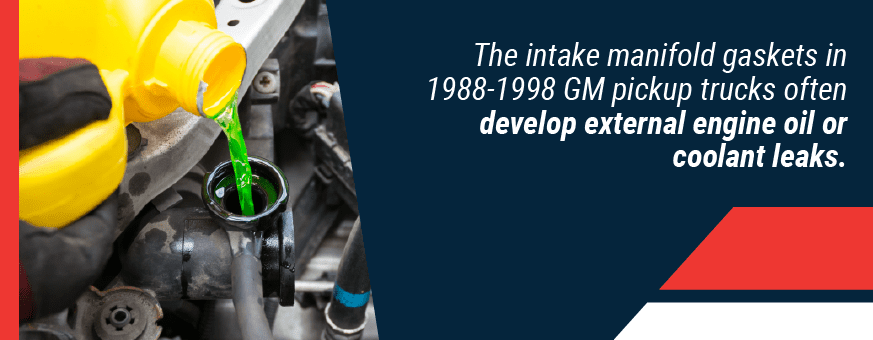
2. Coolant Leaks or Oil Leaks From Intake Manifold Gaskets
The intake manifold gaskets in 1988-1998 GM pickup trucks also often develop external engine oil or coolant leaks. These vehicles may also develop internal coolant leaks that cause coolant to mix with the engine oil, which can damage the engine. This problem most often occurs at around 175,000 miles.
To fix this problem, replace the intake manifold gasket, which will most likely cost somewhere between $300 and $450.
3. Front Wheel Speed Sensor Failure
Another common problem with these vehicles is that the front wheel speed sensors, or anti-lock brake system (ABS) sensors, may fail. This issue may cause the ABS warning light to turn on or the ABS to activate erratically. Many users report the ABS activates on dry roads at slow speeds. You’re most likely to start noticing this problem after 160,000 miles.
To fix this problem, you need to replace the wheel speed sensor, which costs between $150 and $200.

4. Steering Assist Sensor Failure
Many drivers of Chevy and GMC pickups made after 1997 have reported their truck will suddenly lurch to the side, especially while making long, sweeping turns. If you feel the steering jerking while turning, the cause is most likely a bad steering assist sensor. Specifically, the culprit is the electronic variable orifice (EVO) sensor, which is on the steering shaft and determines how much power steering assist to provide. When this sensor goes bad, it may change the amount of power steering assist unevenly, causing the truck to veer to the side.
Replacing the sensor should fix this problem. The EVO sensor costs around $100 and takes around 20 minutes to replace. The sensor is a skinny black doughnut shape and about three inches in diameter. To remove the old sensor, remove the nut and bolt at the bottom of the steering shaft in the truck. The EVO is on the steering column, attached with three clips. Unplug the sensor and carefully lift the clips to remove it. Then slide the EVO off and install the new one.
5. Power Door Lock Actuators Failure
This issue is less common than some of the others on this list, but numerous drivers of GM trucks made from 1990 to 1999 have reported their door locks stop working after around 160,000 miles. This issue may affect the door locking, unlocking or both. A failed door actuator is the usual culprit. Replacing the failed actuators, which costs between $100 and $300, should fix this issue.
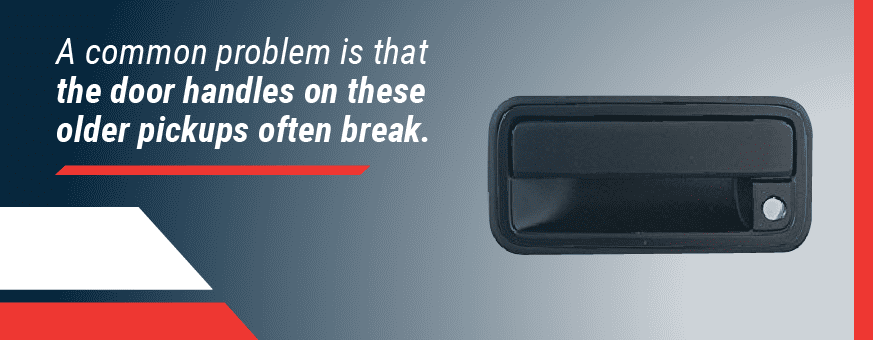
6. Broken Door Handles
Another common problem is that the door handles on these older pickups often break. This issue affects both the indoor and outdoor door handles and most often happens after around 140,000 miles. The door may not open or unlock, or the handle itself may physically break. Typically, it’s not possible to fix these broken handles, and the only solution is to replace them.
7. Idling Problems
90s Silverados and Sierras may suffer from idling problems including a higher-than-normal engine idle. This causes the truck to waste fuel, and some drivers have also said that their engine shuts off when their vehicle is idling. The cause of this issue is most likely that the throttle body gasket has developed a vacuum leak. To fix this problem, you’ll need to replace any failed gaskets. On average, this problem occurs at about 160,000 miles.
8. Abnormal Noise From the Front or Rear Differential
If you drive a Sierra or Silverado made between ’88 and ’98, at around 165,000 miles, you may start to hear an abnormal noise in the front or rear differential. You may hear a clunking, banging or grinding noise and feel a vibration coming from under the driver’s seat. The problem is often caused by worn bearings but could also be the result of another fault. You may be able to fix this problem by replacing the axle bearings if you catch it early, but you often have to do a full rebuild of the affected differential.
9. Alternator Failure
In older Sierras and Silverados, the alternator may eventually fail, causing the battery to die and, possibly, an abnormal noise to occur. This may or may not cause a dash warning light to come on. If your alternator fails, you will need to replace it, which typically costs around $300 to $400. This problem occurs on average at around 125,000 miles.
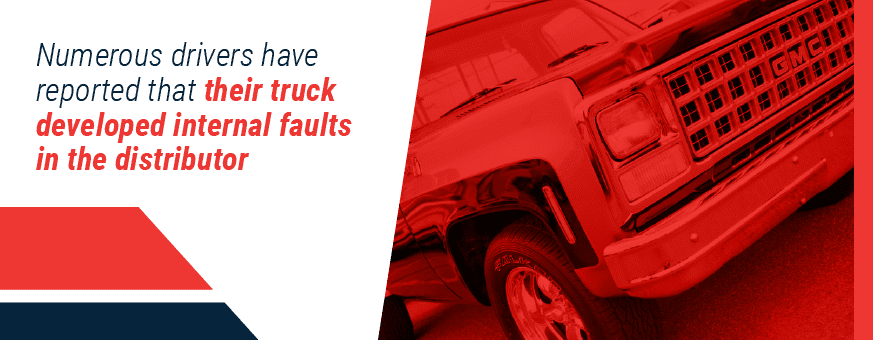
10. Internal Distributor Faults
Numerous drivers have reported that their truck developed internal faults in the distributor, although this problem isn’t as common as some of the others on this list. You may hear a squealing noise coming from the distributor, and the issue may cause the engine to run roughly or stall. The check engine light may or may not come on. You’ll need to overhaul or replace the internal distributor to correct this problem. Start watching out for internal distributor fault issues at around 130,000 miles.
Shop 1988-1998 GM truck parts »
The Evolution of GM Pickup Trucks (1939-1987)
Although the Chevy Silverado and GMC Sierra first became available in 1999, they have a long history here in the United States. They can trace their routes back to the first GM pickup truck in 1918 and, more specifically, to the C/K line of trucks.
Throughout their history, full-sized pickups from Chevrolet and GMC shared many characteristics. Most Chevrolet models had a nearly identical model that sold under a different name from the GMC brand. Chevrolet typically marketed toward individuals, while GMC marketed toward companies that managed fleets.
Let’s take a look at the evolution of GM’s pickup truck offerings over the years.

1. 1973-1987
In 1973, GM released the third generation of C/K trucks. These trucks were the first to feature the square body design with its rounded exterior, which improved its aerodynamic performance. They were also the first dual rear-wheel truck to have a crew cab option with seating for up to six people. These trucks also offered improved padded interiors and were the first to feature curved glass. The 1973 Chevy C30 One-Ton Dually featured a 5.7L V8 engine with 155 horsepower and 255 lb.-ft. of torque. Chevy introduced the Silverado luxury trim package in 1975. Many consider the C30 One-Ton Dually to be the first modern pickup.
2. 1967-1972
The second generation of the C/K series, the Action Line generation, came out in 1967. These trucks, also called the Glamour Pickups, started to focus more on comfort and convenience, rather than just utility. They were still practical, powerful trucks, however, and offered a wide range of engine options.
3. 1960-1966
The C/K line of trucks began in 1960. The first C/K generation offered two body styles. The Fleetside body on Chevy trucks or Wideside on GMC trucks had a smooth panel on each side of the bed. Chevy’s Stepside and GMC’s Fenderside had a contoured panel around the rear wheel wells and a step behind the doors.
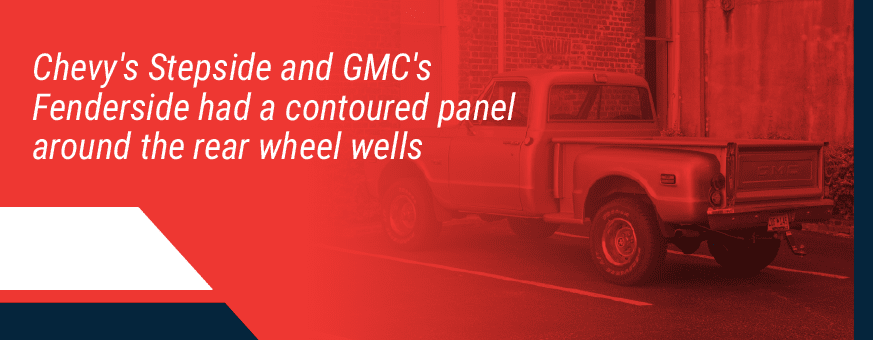
4. 1955-1959
Before the C/K series, in 1955, Chevy introduced the Task-Force generation of trucks. These trucks had the first wraparound windshields, an egg-crate grille, hidden running boards and updated headlights. The interior also got some updates, making the trucks more comfortable. Chevy also introduced its overhead valve V8 engine in 1955, a 265-cubic inch engine with 238 lb.-ft. of torque at 2,000 rpm. During this time, GMC produced its Blue Chip line of trucks, which were similar to Chevrolet’s Task-Force trucks.
5. 1947-1955
In 1947, Chevrolet introduced its Advance Design pickups, which featured a striking new look as compared to older models. These trucks featured a five-bar horizontal grille and a rounded profile, as well as a longer and wider cab that could comfortably fit three people. It also had some new interior features, including an in-dash radio and a fresh-air heater and defroster system.
The Advance Design series included three different truck sizes — a half-ton, three-quarter ton and one-ton models. The 3100 Series, the half-ton model, had a 3.5L I-6 engine with 78 horsepower and 170 lb.-ft. of torque. The three-quarter ton model was the 3600, and the one-ton model was the 3800. In 1954, Chevy released updated Advanced Design trucks, which had a new grille, windshield, steering wheel, instrument panel and parking lights, as well as a more powerful engine.
During the same period, GMC produced its New Design series, which was similar to the Advance Design series.

6. 1939-1946
As the United States began recovering from the Great Depression, GM started to focus more on the design of their trucks. Toward the end of the 1930s, the company introduced newly designed trucks with more powerful engines. World War II started in 1939, and the United States entered the war in December 1941. Because of the war, GM didn’t produce any civilian pickups from 1941 to 1945, but produced thousands of trucks for the U.S. Armed Forces.
In 1941, Chevrolet introduced the AK Series, which featured tougher, more versatile models. The AK Series was the broadest lineup in Chevy’s history. It included nine wheelbases, five axle ratios, three transmissions and two engines. GMC’s versions of the trucks were the C Series and E Series.
Trust Raybuck Auto Body Parts
Raybuck Auto Body Parts is your trusted source for Chevy and GMC truck body panels and other parts, including fuel tanks, interior parts and more. Whether you’re looking to repair a recent model or restore an older one, we have the parts and the expertise you need.
Choosing automotive aftermarket parts over original equipment manufacturer parts can save you a lot of money without a sacrifice in quality. Our rust repair panels feature high-gauge steel, and we offer parts for models as far back as 1947. You can purchase parts to replace just one specific panel section, so you don’t have to redo the whole panel. They also have overlapping metal to connect to the existing structure to prevent rust from spreading to the repaired area.
Want more information? When you contact Raybuck, you won’t have to deal with a phone tree, and you’ll always get a knowledgeable representative right away. Contact us today with any questions you may have.

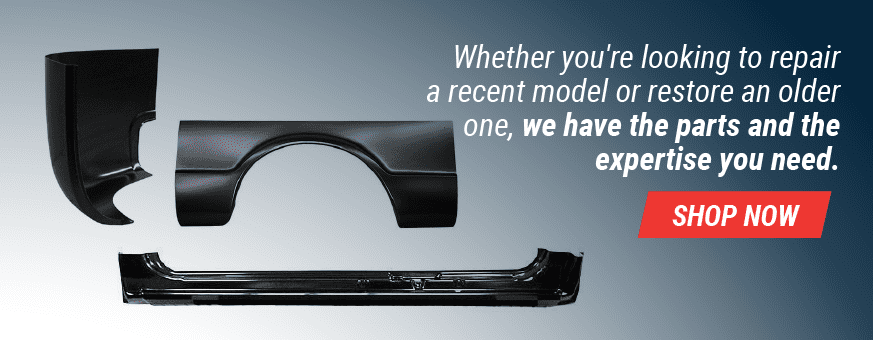

I have a 2003sierra that starts fine when temps are-10 or colder and above +5 Celsius but in between that after sitting all night in the morning it won’t start unless the block heater is plugged in
I have a 1987 4×4 pickup when you step on gas pedal it’s not smooth it lunges all at once & sometimes stalls! Need help!!!
1995 GMC k1500 fuel injector pumping after truck dies won’t idle all new fuel system truck had remote start system added and at some point the two hot wires for the injectors were spliced together I’m thinking for the remote start to work sprayed carb cleaner around throttle body to check for leaks none I detected haven’t gotten to fully trace the wires yet I stopped at the splice and I’m sure it’s not a mechanical issue because if you unplug the injectors or turn the key off they stop but after it dies they run until it’s turned off any advice will be appreciated
Have a 95 GMT 400 k 2500 and it starts idle revs up before Grand no problem put it in gear and it does exact opposite it falls flat on its face. Radiator malfunction it did get hot last winter switch radiator change plugs wires rotor distributor. In the process of going to change a fuel filter I see there is a fuel line leak. I have not checked fuel pressure but would this cause a problem when the truck is under a load. It doesn’t affect it at idle only in gear
I bought a brand new 2007 Chevy cab and Chassis one ton 6.0 Vortec automatic transmission and have had trouble with it since day one the first week I had it battery went out then I had to put two leaf springs on each side of the rear to keep it from bouncing me out of the cab I had a CNM flatbed installed on it I put several headlights in it several tail lights and a bunch of running lights over the years after about 2 months I was coming back from Colorado I live in Texas and the truck quick completely on me it has two fuel tanks on it I had to crawl under it and manually switch the fuel system to where it picked up from the front tank it has never gotten any better than 7.7 miles to the gallon and very little power I might add after about a year and a half after purchasing it the transmission started slipping and you couldn’t take off very fast because when it switched gears it was just rev up and you would have to let completely off and let it shift itself and then get back into the power it’s only got 101,000 miles on it right now you have to put a battery in it every year and a half the driver side door has done everything but fall off after 3 months of owning the truck the fuel gauge is gone to zero and you can’t get it to ever register and I have replaced the complete fuel pump system relay and every other code associated with the fuel system and gauge still have no fuel gauge or interior cabin lighting I am a pipeline welder from Ranger Texas and my name is Jeff Krantz 1425 West Loop 254 Ranger Texas 254-488-1901 thank you very much also had to replace the radiator
03 Sierra 2500, can’t drive faster than 30 mph. What could problem be?
I have a 1992 Silverado when I am making turns left or right the tire/wheels lean/tilt. It has had all the front end parts replaced including alignments trying to correct this issue. Even steering box replaced. Tilt/lean makes u turns and parking difficult. I know I’m not crazy and this not normal . I have not seen a single vehicle function this way, the wheel still stays in the straight up position. Soooo what are the mechanics missing?
Hi Mary, if you’re saying, for example, that the driver side wheel leans outward when you’re making a righthand turn, then that sounds like a caster angle problem. If the wheels are vertical when driving, but then flop out when turning, the caster angle is not correct. This can be caused by misalignment of the control arms, among other things.
Steve if I am driving straight down the road the truck drives straight. But if I turn right both front wheels lean right. And the left turn they lean left. Unfortunately I can’t add a photo. At the shop the guys telling me it’s aligned and that’s just the way it is. I may be a “dumb” female but I know he is wrong. When I went with the complaint many front end parts replaced ($4000.)(the “dumb” female again) the initial complaint still exists. I just need to show,tell,suggest I am not crazy and something needs adjustment. I read something about jacking up one corner under lower control arm ( not the frame) grab the top of the wheel and see what is going on (slop) feel if it, applies to both ball joints? Thanks for anything that can correct this?
Yeah, if you jack the truck up, grab the top and bottom of each tire and wiggle it, it shouldn’t move. If it does, that’s usually indicative of a ball joint problem. The tires should naturally lean when making a turn in either direction. If they are leaning to the point of rubbing, or making it difficult to steer, then that’s usually a caster problem.
Make sure to jack the truck up from the lower control arm, this will remove any tension from the suspension and allow you to check for play in the ball joints.
I didn’t see any thing on the junkie 4l60 e trannies going out at about 120,000 miles. Replaced original with a supposibly better remanufacyured MR. Goodwrench tyrannies from the dealer. Garbage also . 120,000 miles and 4th gear goes out first then 3rd . To Exspensive to keep buying trannies at $1800 dollars and putting them in yourself. Gets old real quick.
my 1995 chevy c1500 idles completely fine, battery charges when driving but when i try to take off from a dead stop the truck tries to stall on me and all the dash lights turn on and off then it runs fine when picking up a little speed.
can someone help please??
There is a single hot wire that goes from the battery up to the junction box on the firewall that feeds the electrical junction box. Check that wire carefully for rubbing on the frame by the upper control arm having an intermediate SHORT. Happened to me in my 88 GMC C2500 that effected my fuel pump. Changed out that wire and it’s all good now. Hope that helps.
Check the ground wire coming from the battery the bolts to fender might need clean the fender and rebolt it that’s what was wrong with mine.
1998 Silverado hesitates at 60mph had it tuned up and after 3 mo. its back replaced all sensors even the map sensor. please advice
I had the same problem, my #4 spark plug wire was bad.
Did you find out what the problem was?
What would cause the windshield wiper motor when he turn it off it goes down to where it’s supposed to be and then it pops up about 2 in
91 Silverado New Valve Covers PCV On passenger side only. Filter oil cap on drivers side, no second hole. Too much oil weeping out of cap causing blow by mess on valve cover and running down onto oil filter over to starter causing a dripping oily mess on my new engine. How to fix and keep a nice look under hood.
I have a 99 Chevy Silverado and it’s making a grinding noise and then it stops. At times my vehicle shudders.. what could cause it?
I have a 2011 GMC Sierra 350 Diesel It turns over but won’t start after just running it hard for 41/2 hrs on a freeway Reach my destination and turned truck off. Then tried to run it It turns over but won’t run WHY
88 one ton dually was having problems with running lights then break lights won’t work next head lights quit working was idling pull out headlight switch and it dies won’t start brand new battery
So how do u fix brake lights when come on
Hell yes I have a 1998 Chevy Silverado with a issue after having a new cam sensor replace the truck won’t start they running won’t pull and then when it heats up it dies any suggestions would greatly be appreciated no I did research it and a friend of mine use his car code system and it says that it’s an O2 sensor can an O2 sensor cause a vehicle not to stay running after it gets hot if it’s out
I have an 89 Chevy Silverado k3500 454 7.4l. I can’t get my headlight to work on the passenger side of my truck it’s the low beam I have the left one but no right side low beam and I have both high beams. I did replace the sealed beam headlight with no results. Could it be a fuse a bad connection or bad wire
Could possibly be a bad connection or broken wire. There should be three wires going to the connector. Pull the headlight, turn the lights on and see if you have power at one of the terminals. Do the same for the high beams (so you know which is which). If you don’t have power at one of the terminals with the light switch in the on position, then I would start working my way back until you find the problem.
1999 c3500 4 door single wheel 586000.0 miles great truck. Original engine transmission rear end. Replaced brakes 3 times alternator once fuel pump once , replaced 3 different door hinge bushings one window motor one blower motor one new AC compressor was still working but front seal was leaking. This is an awesome truck.
I would sure love a new GMC replacement they sure look good.
Will a 98 Silverado Extended cab bed fit on a 06 Silverado extended cab frame?
my 2003 gmc sierra 5.3 4wd ext cab i start it up run it down the road it runs out great then out of no where i start to loose power. If i am at a ide ut seems like ut loads up if i go to take off ifeels like uts out of gas if i pump it i get it to start moving i can not step on it or it ferls like it boggs out please some one help it pulls evap codes
Ground short my 03 gmc sierra done same thing it turned out ground wire check wires from battery to motor is where I found mine
I have a 2003 gmc sierra 4wd ext cab 5.3 i went out to start it and it died out i turned the key again and bith air bags blew out
I’ve replaced fuel pump in my 06 ck3500 4×4 crew cab Dually and it still will not stay running after it initially starts. I hVe jumped the fuel pump relay and had the pump running while I cranked motor and it started as usual but died instantly again. I have sprayed starting fluid into air intake after I start it and it will stay running so I don’t know what to do. It seems like it’s getting spark to stay running by me spraying starting fluid into intake and it stayed running and it seems like the pump is getting signal to keep on as well from me jumping relay and it still only story’s initially.
What’s the odds of a bad fuel pump from store. I just put it in and it’s a $400 pump.
Any ideas
Hard to say what’s going on Heath, but it sounds like either the pump, a clogged fuel filter, a kinked hose, or a fuel tank vent clog.
Sounds like security issue passlock or chip reader malfunction
I have a 98 Silverado 1500 4×4 with the 5.7 5 speed manual vortec motor and ive replaced the battery and starter and it still makes a single loud click when the key is turned what could this be? And how can I fix
Have you tried the starter motor RELAY?
I have a 1989 GMC Sierra four-wheel drive short-term stepside and when I put it in
first it feels like something’s caught in the gear and it just makes a lunge
I have a 2006 Silverado DuraMax diesel motor, Allison Tranny, 4×4 that has been babied since new dealer purchase . At 110,000 miles the hydroboost went out and I lost brakes and steering, then the Turbo charger died. The dealer repair was $4, 300. dollars. Upon complaint to Chevy I was refunded $200.
I have a 1987 chevy truck when I put in gear it ,s like all the wheels are not turning
I have a 2009 chevy silverado 1500 5.3 with the AFM i hate it. Anyway all 4 cylinders are not working on the left side but the truck runs and i can get it up to 1500 rpms what could be causing this please help.
I have a 94 C1500 extended cab with 306K miles. I have an unusual clanging sound from both front wheel but the left seems to be worse that the right. The bearings are good, all the brake components are good and a recent front end alignment didn’t find any bad suspension parts. I’ve had multiple mechanics and Chevrolet look at the problem but it has yet to be diagnosed. Has anyone experienced similar problems?
Yea Same here same year. 94 Chevy c1500 1/2 ton K series. Yet it’s a R-Title and alternate fuel modified (propane) with larger air intake and exhaust. I’ve got all that and then some. Worried bout the gaskets clearly leaking up front somewhere
Yes if it is a “Suspension Going down the road Kind of Clang” check for loose shock Mounting Bolts (shock sliding back and forth on bottom mounting Bolt in the Bracket) or a Broken Weld at the Top of the Shock Tower Cylinder causing a Loose Shock Rock shield that “Clangs on the Steel Shock Rod at every Bump The Fix Replace Front Shocks as a Pair. Also check Motor Mounts and or Transmission Tail Mount for Metal to Metal Contact and Little or No Rubber Left in Mount(s). Other than these check to see that You don’t have a Cracked Frame Rail or Gusset Ect. Hope this Helps.
I have a 1992 GMC Sierra sle 1500,with 160,000 miles.this truck is so strong,very little problems,and looks great.my hat is off to GMC in 1992
Ihave a late 06 z71 that i have teplaced the pedal and the throttle body and im stiil gettig a reduced piwer light and loss of pedal any onput would be greatly appreciated
I have a 2011 chevy 2500 hd…it has close to 200,000 miles and I suffer from same thing …it’s a 6.0 ltr motor and auto trans . Any fixes . I put new throttle body on it fixes for a min. But gets worse thn better and do again it only goes a little . I am forced to pull positive cable in traffic or where ever but it don’t work to fix sometimes ….like now.
I have a 95 k1500 ext cab z71. My truck has 508k miles on the original motor. The only problem is had with it is the trans cooling system. Which in tern has made me replace the tyranny 2 times in the 9 years iv owned it.
The problem with all gm’s is the trans cooling system. Other than that they are great trucks.